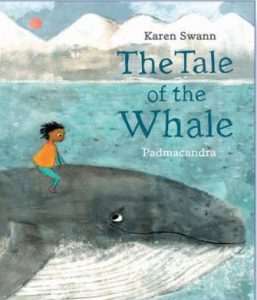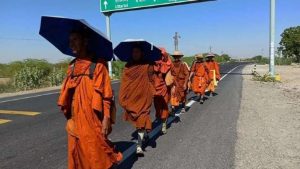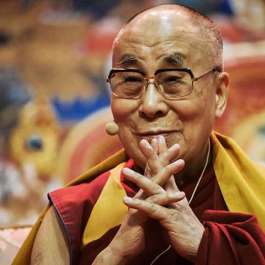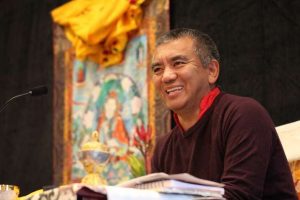
Japanese Shin Pure Land Buddhism was my first taste of meditation and practice, taught in a secular manner by Reverend Taitetsu Unno, my college professor. He and the teachings of Shinran opened my eyes to Buddhism and what was a wonderfully simple and accessible path. From this spiritual perspective, Shinran referred to:
The center of a circle without a circumference as isshiji (one-child-earth). This indicates that each person is the primary concern of great compassion, just as an only child is the sole focus of parental love. Genshin, one of the great teachers of Japanese Pure Land states, “The Buddha’s regard for each sentient being with eyes of compassion is equal, as though each one were his only child; hence I take refuge in and worship the unsurpassed mother of great compassion.” (Unno 153)
In retrospect, I am grateful that my first encounter with Buddhist practice was Pure Land due to its ease of understanding. I could enter into the practice, beginning to sit and recite, in direct opposition to the fabric of my stressed American life. There is an ever-present paradox, or koan, of Shin practice in reciting the nembutsu as personal practice while the motivation is to benefit all beings.
This is our constant struggle—the dynamic push and pull between ourselves and others. While we are in this finite human experience, most of us perceive our own needs as paramount and those of others as secondary. But there are moments when these lines blur and we reach beyond our limitations, within a fraction of a second, to help another—even at our own peril. This reveals something of our true humanity: that which is always latent; waiting to be tapped. Perhaps this is what Buddhism is wholly for, softening the lines between self and other, between the hesitation to act and its counterpart, immediacy. And yet it is not unique to Buddhism among all spiritual or religious paths. Perhaps what makes it unique is the singularity of focus on this central motivation being everything.

Let us return to circle-sitting with the fifth and sixth graders, as shared here in Part One, listening to their questions and arguments, knowing that we would not solve the world’s heartbreak in one session. Will we ever resolve these deep conflicts, the ideological fights, without the softening of our own point of view or recognizing the encompassing sphere in which we all reside? We must see the other across the circles in which we sit—in classrooms, boardrooms, meditation, mediation, restorative justice, negotiation, and even bedrooms—without seeing others as less deserving than ourselves of care, comfort, shelter, voice, freedom, and space.
In Shin Pure Land:
. . . the nembutsu calls us without judging or condemning our refusal to hear; rather, it pursues us relentlessly with deep sorrow for the foolish self that chooses darkness. Yet, the ego-self ultimately undergoes a miraculous transformation, such that the very stubbornness cannot but become supple, open, and malleable. All this occurs as a natural process…religious life does not require us to be ‘good’ or ‘virtuous’ as a condition. The only requirement is the openness to the beneficent, transforming power of the Primal Vow. (Unno, 119–20)

Of course, this text is written for practitioners who have taken refuge in the path, for those who believe in its power and efficacy. But it poignantly highlights this: We don’t need to eradicate evil; rather we need to seek it within ourselves, becoming aware enough to soften the edges that carve a weapon between myself and my perceived enemy. When this subtle shift occurs, we can admit that the circle of life means that our own karma is our greatest teacher. It will bring us back to the same lessons and experiences if we do not address them now. We see that at the root of our suffering as well as others is our attachment to ego and being right. Our thinking that we know best.
Thus it is stated:
Such sorrow—
The cry of true compassion
Sinks into my hard ego. (Unno, 119–20)
This is how one can transform strong attachment to oneself in Shin Buddhism . To exist, simply and authentically, we must soften.
This reminds me of a beloved story in Vajrayana, specifically in mantrayana practice, wherein a yogi throws down his mala and walks away after 12 years of reciting the deity’s mantra, as he feels no result. Then, suddenly, he hears the deity reciting his name and is stunned into recognition of the true nature of reality.

The Sanskrit term for compassion, karuna, contains the root term implying painful moaning or groaning arising from identification with the pain and suffering in the world. This was the inspiration for the Primal Vow, awakened by Dharmakara Bodhisattva, out of profound sorrow for beings drowning themselves in the ocean of samsara. . . . Fulfillment of the Primal Vow was given to us as the nembutsu, ‘namu-amida-butsu.’ This is the Name-that-calls, penetrating to the core of my being—proud, stubborn, arrogant, deceitful, foolish. (Unno, 119)
I share this piece of wisdom from the book River of Fire, River of Water by Taitetsu Unno, my very first Buddhist teacher, for the purity and deep simplicity of these practices and refuge-taking. As I’ve said many times, we all take refuge every day in so many ordinary things and ways of being. In food, sex, media, addiction, anger, even righteousness. The fear that many have in taking refuge in a spiritual path or practice is an unreasonable and unfounded fear. It is the fear of replacing tired and useless refuges with those that will liberate us. But fear of liberation is natural for human beings as we cling hard to what is known with our childish, ignorant habits.
Ordinary refuge is usually ego-based and fear-based. But when we take the long view, which is circular, spiraling, spherical, of lives unfolding and recurring, then we can take some solace in this recurrence. I was recently able to spend time with a dying relative and be in that state of grace between life and death where none of us knows truly what is coming. There is a relinquishing of fear and attachment into that unknown. My relative was a stubborn, difficult man, but in the end he was able to go gently into that good night and embrace the state of grace that exists when we accept that one ending opens into a new beginning. When we stop fighting, there is space that can open anew.

References
Unno, Taitetsu. 1998. River of Fire, River of Water: An Introduction to the Pure Land Tradition of Shin Buddhism. New York: Penguin Random House.
See more
Why Is It Important to Meet a True Teacher? (Orange County Buddhist Church)
The Working of Boundless Compassion (Barre Center for Buddhist Studies)
Related features from BDG
Circles of Life and Death, Part One: Recalling Thich Nhat Hanh and Black Elk
A Pure Land on the Rhine: Rev. Marc Nottellmann and the Eko House
The Story of the Chocolate Buddha
The Deep and Broad Meaning of Rebirth in the Pure Land
Book Review: Pure Land: History, Tradition, and Practice
Cleaning Our Minds and Seeing the Pure Land














